First Flight:
Bjoern Eriksen
![]()
First Flight:
|
|
by Alfred Scott
|
This article appeared in the March 1991 Falco Builders Letter. |
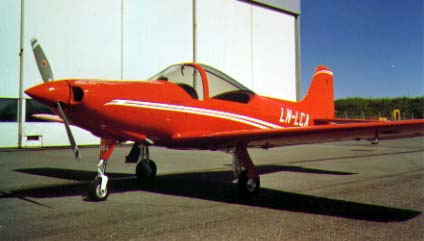
Another Falco flying -- this one is in far-north Norway, and the proud builder is Bjoern Eriksen.
It's always interesting to find out something about people who build Falcos, and I asked Eriksen about his background. He began flying sailplanes at the age of 16, and later enlisted in the Norwegian Air Force where he worked as a mechanic on F-86s for two years. While in the Air Force, he started taking flying lessons and got his private and commercial licenses in 1960, and to earn money for his ATP rating, he did major overhaul work on light aircraft during the winter time.
Out of the air force, he worked at a seaplane pilot for a small company in northern Norway in 1964, and the following year got a job with Wideroes Flyveselksap, which is now one of the largest airlines flying domestic routes in Norway.
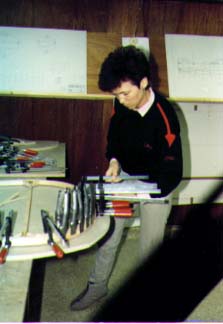
Torill Eriksen making a fuselage frame
In 1967, the Norwegian government began a massive construction project of building small airports along the Norwegian coast, which is quite long and difficult to reach by anything other than air or sea. Wideroe was chosen as the sole operator of these small airports-most runways are only 800 meters long -- and today they serve about 48 airports with a fleet consisting of eight Dash-7's and 12 Twin Otters.
In the process of building up the organization, Bjoern Eriksen was busy flying as chief pilot as well as an instructor. This took many hours of work, and in the late '70s, he stopped instructing and continued to fly as captain of a Dash-7, which he still does to this day.
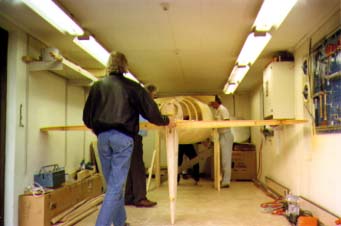
The change to ordinary flying duties gave him plenty of time off, and he soon felt he could do a lot more. It was at this time that we began selling plans for the Falco. Captain Eriksen was already well aware of the Falco, having followed it from the first article in 1955 in Flight International magazine and then later when the aircraft was offered for sale in Norway-but none was ever sold there.
"From the first time I saw it, I have wanted a Falco, but it had always been out of economical reach," says Eriksen. "But in 1980, the cards all of a sudden fell into place. I had the time to build one, the drawings were offered together with some essential kits, and I had the money to start."
"Our one-car garage was stripped and painted in light colors, new and very good lights and a heating system were installed. I was ready to start, but the project needed careful planning, as my workspace was only 3 by 7 meters." Now, let's put that in English measure, that's 9 feet by 21 feet. That's a tiny space in which to build a Falco -- "So small you have to go outside to change your mind" goes the old saw.
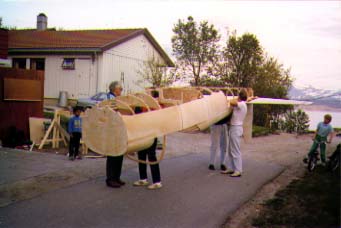
The Falco was built very systematically. The first year was spent building ribs. Then another year was spent building the fuselage frames. Another year for the spars. Bjoern Eriksen's feat at building the Falco in this tiny space was a genuine Houdini stunt, and it is amazing that he accomplished it at all. The intriguing thing is that he figured it all out in advance, and the concept worked well.
He built the tail group and fuselage first, and completed the fuselage-without the wing-to a degree that is astonishing. The canopy, engine mount, engine, nose gear, and cowling were all completed before the wing was begun. The tail section was cut off and prepared for painting, as well as a short section of the fuselage centersection to ensure a perfect fit after final assembly.
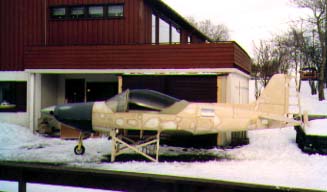
Then it came time to build a small, 1.5-meter extension to the garage to accommodate the wing. The ceiling height was not sufficient to build the wing in the normal vertical jig, so he had to build it horizontally -- a process which "involved very careful jigging."
The fuselage section was put in the garage in a horizontal position, and then the main wing spar was carefully nested into place by inserting it through the fuselage. "I had figured out that this would work out, provided I kept the dimensions exact to the drawing. It did." When it came time to float-sand and skin the bottom of the wing, they would take the plane out of the garage, turn it over and walk it back into the tiny space.
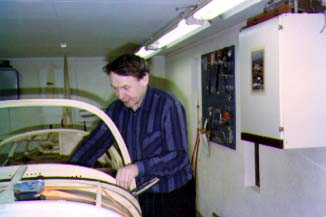
Bjoern Eriksen
The wing and fuselage centersection were completed all the way to painting readiness in the garage. Finally, the parts were moved to a professional car painter, and the Falco got its red color. Captain Eriksen reports, "He did a very good job, and the finish is very nice." The paint scheme was modified to suit the large letters required in Norway. All of the white striping and lettering is actually adhesive-backed plastic film.
The Falco was then taken to the Wideroes hangar at the airport, where Bjoern Eriksen did the final assembly-a process that took 1-1/2 years.
Eriksen says, "I have tried to keep the relation with the Norwegian CAA at a very professional level, and this has paid off. They are very pleased with the project as a whole. The rules in Norway are a bit more stringent than in the U.S. but quite okay if you are serious about what you are building."
"The main problem building an airplane here in Norway is the astronomical cost due to freight and currency exchange rates. As a project, I am very happy with the Falco. There has been a very high quality on the drawing and parts from Sequoia, and the product support has been very good. However, I would like to mention that there have been some problems with the engine mount, canopy and fuel tanks. When you live in Norway, this makes problems even when Sequoia offers new parts, due to the fact that the freight costs for the exchange of the parts exceeds the cost of the parts."
"I think it should be pointed out that to build a Falco requires a no-nonsense adherence to drawings and a generally good knowledge of aircraft construction practice. There are mistakes that you can make even with a very good construction manual at hand."
Bjoern Eriksen's Falco has a 160 hp IO-320-B1A engine and a standard canopy. It's the first Falco to fly with a red-and-white paint scheme and a standard canopy, and its gorgeous appearance confirms a theory that I've always had that the appeal of Karl Hansen's Falco has much more to do with the paint scheme than the Nustrini canopy.
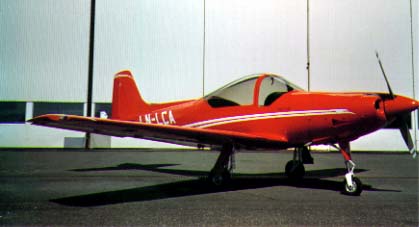
The first flight of the Falco took place on February 22, and Eriksen reported that the flight lasted for 45 minutes and that the aircraft behaved just as expected. That makes LN-LCA the 29th Sequoia Falco to fly.
As I write this, he now has 6 hours on the Falco and has started flutter testing. He says, "The aircraft goes straight as an arrow at cruise and has a true airspeed of 170 knots at 10,000' with 65% power, and the climb rate averages 1400 fpm to 6000'. "This is with doors on nose and main gear legs only. The aircraft won't have more doors as I don't think that is doing any good for the reliability of the retraction system. Please take the performance figures as preliminary, as that type of testing has yet to start."
Bjoern, Torill Eriksen and their son, Morten, live in Bodoe, Norway, a town of 14,000 people that's north of the Arctic Circle. Best wishes to them all for many happy years with their Santa Claus-red Falco.
|
|